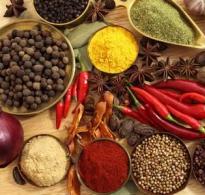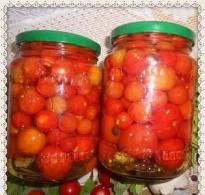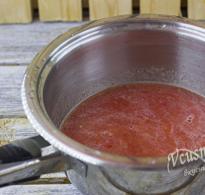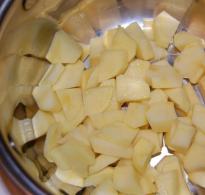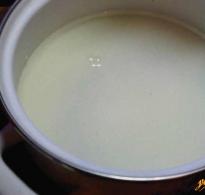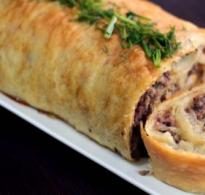Dal - a recipe for making Indian mashed pea soup. Dal - a recipe for making Indian mung bean puree soup Dal pea soup
The famous Indian Ayurveda is not just cooking, it is a mysterious country filled with magical symbols. The main dish in it is dal - a soup made from beans, vegetables and many other ingredients. Let's make a reservation right away that this dish is not for meat-eaters, in it you will not find a grain of meat, only vegetables and spices. He also has a second name - mung dal, indicating the fact that they prepare soup from small peas, called mung in India.
Soup secrets
Mung peas are indicated in the basic recipe for dhal soup, but dhal can also be cooked with other legumes: lentils, ordinary peas. The main thing is that the beans are boiled down to such a state that you can easily knead them with your fingers. The final step in cooking the dish is frying the spices in ghee oil. And here it is, the mystery. What is ghee oil?
We take the butter, melt it, remove the foam formed on the surface, in the remainder we get a transparent consistency, which is the same ghee butter. We introduce it into the dal soup along with the spices fried in it. You will need a lot of spices, but the basis is garam masala (a classic Indian spice mixture).
In some states of India, mung dal is prepared, but if you try this soup, you will not find any differences from the basic recipe. The only thing that can introduce subtle nuances into the flavor bouquet of dal soup is the arbitrary dosage of spices and seasonings by the hostess herself.
Spices in ghee oil are fried step by step, following a certain sequence of placing them in hot oil.
Basic soup dal
The impressive amount of ingredients included in the basic recipe is impressive, and it seems that dal is a complex dish. Let's not be scared, because in India, dhal is prepared in many families just for dinner. So, here is what we will take for this dish: 
- orange lentils - 400 grams;
- bell pepper - 2 pieces;
- cauliflower - 5-6 inflorescences;
- onion - 2 large heads;
- tomatoes - 3 pieces;
- carrots - 1 piece;
- garlic - 5 cloves;
- dried ginger - 1 teaspoon;
- turmeric, curry - 1 teaspoon each;
- zira - ½ teaspoon;
- salt to taste;
- ghee oil for frying spices;
- basil, parsley, cilantro for sprinkling when serving.
Cooking:
- Sort the lentils and soak for 2-3 hours. Dhal can be made from any variety of lentils. In our recipe, we took orange, which cooks faster.
- Pour the soaked lentils into a saucepan, pour 2 liters of water, wait for the water to boil, reduce the intensity of the fire, cook for about half an hour.
- We turn to the processing of vegetables. We clean the onion and garlic, remove the grains from the bell pepper, wash all the vegetables.
- We cut the sweet pepper into rings, finely chop the onion and carrot, cut the tomatoes into small cubes.
- Cut the garlic cloves into large pieces.
- Boil the cauliflower florets. We do not pour out the broth, we will need it for the soup.
- We get ghee oil (see description above). Pour the transparent mass into the pan, heat it up. We fall asleep carrots. Fry for 2-3 minutes.
- Add zira, turmeric, curry to the pan in turn. Stir, let fry for 3-4 minutes.
- Pour vegetable oil into another pan, fry the onion in it until golden brown. Add ginger and garlic to it, warm it up a little, and send it to another pan with carrots and spices. We don't turn off the fire.
- We report to the languishing mass cubes of tomatoes and half rings of bell pepper. We introduce cauliflower. Close the lid and simmer for another 3-4 minutes.
- Add the prepared vegetables to the lentils in the pan. We add broth. Sprinkle with salt and black pepper. Simmer for one minute. Turn off. We wait 5 minutes for the soup to infuse.
- Pouring Indian dal soup on plates, sprinkle it with herbs.
mung dal recipe
We have already said that dal is the national dish of Indian cuisine, but, as is often the case in cooking, there are a lot of recipes for cooking the dish. We suggest you prepare one of them. For this you need to take:

- a mixture of different varieties of lentils - 1 cup;
- large head of onion;
- tomatoes - 4-6 pieces;
- garlic - 4-5 cloves;
- turmeric - 1 teaspoon;
- ginger to your taste;
- vegetable oil - 2 tablespoons;
- butter (for dressing) - 3 tablespoons;
- zira - half a teaspoon;
- mustard seeds - 1 teaspoon;
- dill or cilantro - 1 bunch;
- chili pepper - 1-2 pieces;
- vegetable broth - 3 cups;
- pepper and salt to taste.
Cooking:
- The mixture of lentils should be thoroughly sorted out and washed, soaked for 2-3 hours.
- Pour vegetable oil into a saucepan, bring to a boil.
- Mince garlic, ginger and onion. We put it in a saucepan in this order: garlic, after 2-3 minutes onion, after 2-3 minutes ginger. Add diced tomatoes and simmer until all ingredients soften.
- We shift everything into a saucepan, add lentils, dilute with vegetable broth, cook until fully cooked.
- While the base is cooking, make the dressing.
- We heat the butter in a pan, remove the foam, add cumin, mustard seeds, chili peppers. Fry until the mustard seeds begin to "jump" out of the pan, exploding from the heat. We shift the contents of the pan to the ingredients in the pan, simmer for one minute, turn off.
Decorate the dal fry with finely chopped cilantro or dill.
Varieties of dal soup and their features
Most of the dal components are identical, only the bean base changes. For example, dal makhani is cooked on black peas, and for Russian cuisine, dal can be made from ordinary peas. If you come across a recipe for dal tadka in Ayurveda, then don’t be surprised, just look at our recipe for dal fry and you will understand what kind of dish it is.
Dal, according to the book Vedic Culinary Art, are shelled lentils or peas. And also this name is the soup made from these products. Thick pea soup can serve as a condiment for rice, for example, or served as an independent dish with bread.
To prepare dal based on the recipe from the above book, you will need dry (ideally washed, dried and sorted) peas. As for vegetables, you can use carrots and potatoes, but this will not be an Ayurvedic recipe, because. Ayurveda does not welcome the combination of potatoes and legumes. The book lists just vegetables, and you can choose which ones. It turns out very tasty even just with carrots, herbs and Adyghe cheese (paneer) grated on a coarse grater. An important condition for dal is that the peas must be well boiled.
To do this, it must be immersed in boiling water or poured with boiling water (!!! IMPORTANT !!!). Add bay leaf (you can put another teaspoon of vegetable oil, which will prevent abundant foaming, as well as a little salt and a tiny pinch of ground cinnamon - this is the secret advice of an Indian chef).

Bring the peas to a boil, remove the foam and cook over low heat until almost completely boiled.

Peel the potatoes, cut into cubes, grate the carrots on a coarse grater.

Put in a saucepan. Salt and cook until the vegetables are fully cooked.

In a small bowl, heat vegetable oil or ghee, add spices (turmeric, black pepper, cumin, curry). Put freshly grated ginger into hot spicy oil. Fry it for a minute.

Put the hot (still boiling) oil and chopped fresh herbs in the distance. Add some asafoetida.
Description
Dal One of the most nutritious vegetarian dishes in Indian cuisine. This is a creamy bean soup with lots of spices. To prepare it, beans (usually beans, lentils, chickpeas or mung beans) are boiled to a soft state, and then mashed and seasoned with fried spices, the set of which is different for different housewives.
Despite the fact that dal is a classic Indian dish, which is extremely rare in our country, you can easily cook it at home, especially if you use our recipe with a photo.
Dal beans need to be soaked first. Red lentils are soaked for at least an hour, green and our green peas - for 4 hours, chickpeas and mung beans ("mouse peas") - for 12 hours, or longer. After that, you need to cook them for at least half an hour, or rather, until the moment when the beans become so soft that they can be kneaded with your hands. As for spices, they are fried about 5 minutes before the beans are ready, and ideally in ghee (clarified butter prepared in a special way), but if it is not available, vegetable oil can also be used.
Now that all the instructions are given, let's start cooking!
Ingredients
-
Mung bean (mung bean)
(2 glasses) -
(1 PC.) -
(5 cm) -
(2 tablespoons) -
(1 tsp) -
(1 tbsp) -
(1 tbsp seeds) -
(1.5 tsp) -
(2-3 tablespoons)
Cooking steps
We prepare the ingredients. Please note that the beans (in our case it is mung bean, but you can take any others of your choice) have already been soaked overnight, and we chopped the onion and ginger root with a knife.
Pour beans with water in a ratio of 1:3, respectively (i.e., for 2 tablespoons of beans - 6 tablespoons of water). Put chopped onion and ginger in the same saucepan and cook over low heat for at least half an hour. The beans are a must!

While the mung bean is being cooked, we process the spices that I gave in different recipes - different. In general, the minimum set of spices for this soup consists of zira (cumin) and hot pepper. But we will add dill and coriander seeds to them to make the dal more tasty and fragrant.
Fry each of the spices, stirring constantly, over low heat in a dry frying pan separately from the others so as not to mix the flavors. At the same time, we carefully monitor that the spices do not burn, and if this happens (which is quite possible, because they burn out very quickly), we throw away the spoiled ones without regret and start re-frying a new batch. After that, grind the spices in a coffee grinder or in a mortar, pour into a saucer and season with salt and hot chili (if you don’t like spicy, you can skip the last ingredient).
Fry this mixture in a frying pan in hot ghee or vegetable oil, again carefully watching so that nothing burns.
We send the warmed and oiled spices to the dal, mix well, and then we puree everything together in a blender. True, not everyone likes dal in the form of mashed potatoes, so sometimes the stage with a blender is skipped and the beans are left as a whole, albeit in a semi-boiled state. But we still blend.
Ready-made Indian dal soup is served with boiled basmati rice or simply with bread, flatbread or pita bread.

Bon Appetit!
Indian cuisine is a treasure trove of vegetarian recipes with lots of spices. Curry is considered to be the main spice in India, it is added to a large number of traditional dishes. However, along with vegetarian recipes in Indian cuisine, you can find chicken dishes. This is largely due to the fact that the culinary preferences of the Hindus were formed on the basis of two religions - Hinduism and Islam. We will tell you how to cook Dal, a delicious national dish.
A rare Vedic meal is complete without a nutritious dal - a thick bean soup. The dish should be liquid, but uniform in density.
Ingredients:
Yellow peas - 200-250 g
Water - 1.5-1.7 l
Potato - 250 g
Carrots - 50 g
Bay leaf - 1 pc.
Vegetable oil (or ghee) - 1 tbsp.
Raw grated ginger - 0.5 tsp
Spices - to taste
Greens - to taste

Cooking:
Dal, according to the book Vedic Culinary Art, are shelled lentils or peas. And also this name is the soup made from these products. Thick pea soup can serve as a condiment for rice, for example, or served as an independent dish with bread.
To prepare dal based on the recipe from the above book, you will need dry (ideally washed, dried and sorted) peas. As for vegetables, you can use carrots and potatoes, but this will not be an Ayurvedic recipe, because. Ayurveda does not welcome the combination of potatoes and legumes. The book lists just vegetables, and you can choose which ones. It turns out very tasty even just with carrots, herbs and Adyghe cheese (paneer) grated on a coarse grater. An important condition for dal is that the peas should be well boiled.
To do this, it must be immersed in boiling water or poured with boiling water (!!! IMPORTANT !!!). Add bay leaf (you can put another teaspoon of vegetable oil, which will prevent abundant foaming, as well as a little salt and a tiny pinch of ground cinnamon - this is the secret tip of an Indian chef).
Bring the peas to a boil, remove the foam and cook over low heat until almost completely boiled.

Peel the potatoes, cut into cubes, grate the carrots on a coarse grater.
Put in a saucepan. Salt and cook until the vegetables are fully cooked.
In a small bowl, heat vegetable oil or ghee, add spices (turmeric, black pepper, cumin, curry). Put freshly grated ginger into hot spicy oil. Fry it for a minute.
Put the hot (still boiling) oil and chopped fresh herbs in the distance. Add some asafoetida.
Mix and serve.

See also:
Vedic cuisine(that is, primordially Indian) I like the fact that almost from scratch you can create a full meal. “Empty place” I call the absence of meat, poultry, fish at hand, with which you can do anything, because this is the base of the usual cooking for us. God forbid, of course, to be left without meat, fish and poultry, but sometimes the minimalism inherent in most vegetarian recipes is very good in itself. It’s so good that you are amazed at how it could have turned out in terms of completeness and self-sufficiency in the context of taste perceptions. In this sense, Vedic cuisine is an excellent example of how, with the help of its traditional technological tricks, you can get a dish that is not inferior in taste and aroma to most flowery oriental dishes with meat, fish or poultry.
Sitting in the country, I cooked channe ki dal, a kind of "snake soup", to the name of which in India they often add the name of the city where it is especially popular - Jagannatha Puri. If the word "Jagannath" does not mean anything to you, then, simplifying the Indian verbal and philosophical tie, let me remind you: this is Krishna. And the soup channe ki gave - Krishna's favorite food, which, having prepared, is always placed in front of his image, thus paying tribute and love to the Ruler of the Universe. Unfortunate rite! But we, cooks, are all the more interested in what kind of soup this is, to which Krishna always smiles gratefully.
Let's take four servings:
1. A glass of dry chickpeas, which must be soaked in water (with the addition of a teaspoon of baking soda) for at least 10-12 hours. Instead of chickpeas, our regular yellow peas are quite suitable.
2. Two tablespoons of ghee or butter (hard vegetarians do vegetable)
3. Tablespoon grated ginger
4. Two pinches of zira.
5. Two cloves of garlic. In India, asafoetida is used, a spice obtained from the root of ferula stink. In taste, aroma and smell, this spice strongly resembles garlic, only with a sharper expression. So harsh that I honestly don't like asafoetida. I don't think most of you will like it. If you want to try it - please go to the Indian spice shop - a teaspoon of asafoetida is enough for this soup.
6. Three to four tablespoons of either confectionery coconut flakes (always available in the markets) or freshly grated coconut pulp.
7. Five to six fresh tomatoes
8. Lemon.
9. Two bay leaves.
10. A tablespoon of molasses or honey.
10 Salt, pepper to taste, herbs for decoration.
So, pour soaked chickpeas with two liters of cold water, add two teaspoons of salt and two bay leaves and set to boil.

On average, soaked chickpeas boil until soft within an hour. But it needs to be boiled until fully cooked, constantly removing the foam.
While the chickpeas are cooking, prepare the dressing for the soup. In a spoonful of butter or ghee dissolved in a frying pan, slightly stew a couple of pinches of zira, then add a tablespoon of grated ginger, two well-chopped garlic cloves, three to four tablespoons of coconut flakes or grated "pulp" of coconut. And at low temperature turns, put out this mixture for 2-3 minutes.

Set the dressing aside and move on to the tomatoes. After cutting each tomato crosswise, scald them with boiling water in a suitable bowl, remove the skin, remove the tough flesh from the petiole and cut into slices. Let's try peas. If it is cooked, add tomatoes and a tablespoon of butter to the pan and leave to cook for another 10 minutes.

After 10 minutes, add dressing from a mixture of cumin, garlic, coconut and grated ginger.

Next, add a tablespoon of molasses or honey.

Let the soup boil slightly for another 2-3 minutes and, exactly according to Pokhlebkin, we will finally balance it for salt-sweetness - acid-sharpness, adding, if necessary, granulated sugar, salt, pepper and lemon juice. Let's brew for 20 minutes. Add a circle of lemon, a few circles of hot pepper and some fresh herbs to a serving plate.


